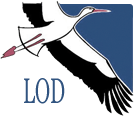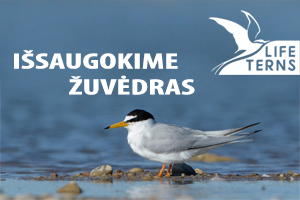Data on protected species – for their protection
The main issue of conservation is the lack of data about distribution, abundance and , in particular, exact location of findings of protected species. Although they are often identified, all information is found in the notes of individual researchers or in private archives. Therefore, the data on protected species, if not published or recorded on special data basis or information systems, are not used planning general type of protection measures and cannot guarantee that species found by individual observers can be protected by the Law on protected species of the Republic of Lithuania, or other national or international law. This problem is particularly acute while planning economic activities (even in accordance with the appropriate procedures), particularly during spatial planning. If data on rare species sites are discovered after approving spatial or other planning documents, it is often impossible to protect sites of endangered species, or it causes conflict situations with land users or developers. However, this problem can be easily solved by publishing data of individual researchers or naturalists with exact sites of protected species, abundance and status of local populations.
Currently, the most appropriate instrument for this is the Information System of Protected Species (SRIS) administered by the Ministry of Environment, where all published records have a special legal status, and the existing information about protected species must be assessed while planning any economic activity or preparing territorial plans of development. Therefore, until making complete researches of distribution of protected species in Lithuania, it is the most important to collect all available, including historical, data about the exact sites of such species all over the country. Thousands of such records are currently in the notes and archives of individual researchers and scientists. They should be all published in the official information databases accessible to society and decision makers, where only approved data can be recorded. On the other hand, it is important, that such data would oblige development specialists. The SRIS is the system, meeting these criteria, and any record published in the system has some legal status. The biggest effect could be achieved if naturalists of the country (hundreds of people) were involved in registering sites of rare species. It is important that this information is correct. Therefore, we believe, that collecting the data on the sites and status of protected species is one of the priority tasks ensuring stopping of biodiversity loss. Our national goal – to ensure the conservation of biodiversity – can be achieved only in this way. What is more, centralized collection and publication of available data is much more effective in relation to the time and money than organizing and financing new researches. Much less funds are necessary to cover the costs of “desk job” of researchers to enter the data in the SRIS. Meanwhile, organizing studies, in addition to general coordination, it is necessary to cover travel and other costs. Finally, all the collected data has to be published in the SRIS. This would take several years, however, until then, part of the sites of protected species could be destroyed, while entering available data would take much shorter time. Members of Lithuanian Ornithological Society have a lot of data on the sites of protected bird species, so our plan is to provide the data generally on this group of fauna. However, we plan to provide sites of protected plants, fungi and other groups of fauna, thus ensuring a wider and more complex conservation of biodiversity. Our plan is to provide the data on the sites of not less than 10.000 animal and 2000 plant species . If proper implementation of national legislation is guaranteed, we can expect all these sites will be saved.
http://www.eeagrants.lt/en/programmes/projects/program/23/id/93/data_on_protected_species_for_their_protection_



















